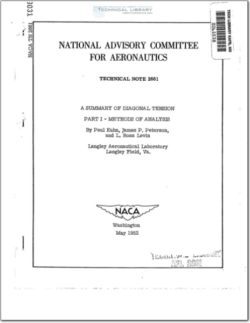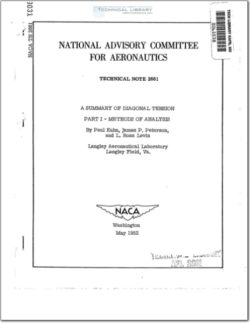NACA-TN-2661

- Version
- 1775 Downloads
- 4.53 MB File Size
- 1 File Count
- December 4, 2015 Create Date
- December 4, 2015 Last Updated
National Advisory Committee for Aeronautics, Technical Notes - A Summary of Diagonal Tension Part I-Methods of Analysis

Previously published methods for stress and strength analysis of
plane and curved shear webs working in diagonal tension are presented
as a unified method. The treatment is sufficiently comprehensive and
detailed to make the paper self—contained. Part I discusses the theory
and methods for calculating the stresses and shear deflections of web
systems as well as the strengths of the web, the stiffeners, and the
riveting. Part II, published separately, presents the experimental
evidence.
The development of diagonal-tension webs is one of the most out-
standing examples of departures of aeronautical design from the beaten
paths of structural engineering. Standard structural practice had been
to assume that the load—bearing capacity of a shear web was exhausted
when the web buckled; stiffeners were employed to raise the buckling
stress unless the web was very thick. Wagner demonstrated (reference 1)
that a thin web with transverse stiffeners does not "fail" when it
buckles; it merely forms diagonal folds and functions as a series of
tension diagonals, while the stiffeners act as compression posts. The
web—stiffener system thus functions like a truss and is capable of
carrying loads many times greater than those producing buckling of the
web.
For a number of years, it was customary to consider webs either as
"shear—resistant" webs, in which no buckling takes place before failure,
or else as diagonal—tension webs obeying the laws of "pure" diagonal
tension. As a matter of fact, the state of pure diagonal tension is an
ideal one that is only approached asymptotically. Truly shear—resistant
webs are possible but rare in aeronautical practice. Practically, all
webs fall into the intermediate region of "incomplete diagonal tension." A
An engineering theory of incomplete diagonal tension is presented herein
which may be regarded as a method for interpolating between the two
limiting cases of pure—diagonal—tension and "shear—resistant" webs, the
limiting cases being included.
| File | Action |
|---|---|
| naca-tn-2661.pdf | Download |

Comment On This Post